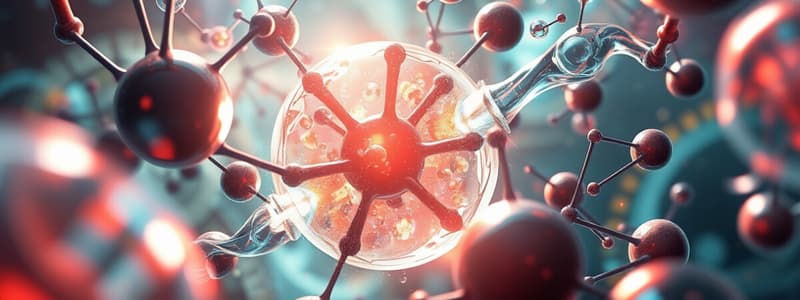Podcast
Questions and Answers
What defines a strong electrolyte?
What defines a strong electrolyte?
- Non-conductive in aqueous solutions
- Completely ionized in water solutions (correct)
- Only conducts electricity in solid form
- Partially ionized in water solutions
Which of the following is an example of a non-electrolyte?
Which of the following is an example of a non-electrolyte?
- NaOH
- Ca(OH)2
- C12H22O11 (correct)
- HCl
What is the primary characteristic of a weak electrolyte?
What is the primary characteristic of a weak electrolyte?
- Only ionizes under high temperature
- Completely ionizes in water solutions
- Does not conduct electricity at all
- Remains mostly unionized in water solutions (correct)
What evidence indicates an irreversible reaction has occurred?
What evidence indicates an irreversible reaction has occurred?
Which reaction is governed by the law of equilibrium?
Which reaction is governed by the law of equilibrium?
What is the primary focus of biochemistry?
What is the primary focus of biochemistry?
Which of the following is NOT a type of biomolecule discussed in biochemistry?
Which of the following is NOT a type of biomolecule discussed in biochemistry?
What aspect of biochemistry includes the functions and metabolic activities of biomolecules?
What aspect of biochemistry includes the functions and metabolic activities of biomolecules?
What do we call the process of converting a substance into an active metabolite?
What do we call the process of converting a substance into an active metabolite?
Which type of carbohydrate is glucose classified as?
Which type of carbohydrate is glucose classified as?
What is the role of buffers in relation to pH levels?
What is the role of buffers in relation to pH levels?
Which of the following statements is true regarding molecular biochemistry?
Which of the following statements is true regarding molecular biochemistry?
Which biomolecule is responsible for the storage and transmission of genetic material?
Which biomolecule is responsible for the storage and transmission of genetic material?
Study Notes
Introduction to Biochemistry
- Biochemistry combines biology and chemistry to study the chemical processes within and related to living organisms.
- It examines biomolecules, which are essential for life's processes.
Chemistry Overview
- Chemistry is the science that explores matter's composition, properties, changes, and the energy involved in these changes.
- It includes two major branches:
- General and Inorganic Chemistry: Focuses on elements in the periodic table.
- Organic Chemistry: Studies carbon-containing compounds.
Biomolecules
- Biomolecules are carbon-based compounds produced by cells.
- They vary in size and structure and are fundamental to life.
Four Main Types of Biomolecules
- Proteins: Composed of amino acids; examples include collagen and keratin.
- Carbohydrates:
- Monosaccharides: Glucose
- Disaccharides: Sucrose (table sugar)
- Polysaccharides: Starch
- Lipids: Include glycerol; non-polar substances like fats, oils, cholesterol, and steroids.
- Nucleic Acids: Made of nucleotides; responsible for storing and transmitting genetic information.
Molecular Biochemistry
- Focuses on macromolecules and their metabolic functions in the body.
- Includes processes such as digestion, absorption, assimilation, utilization, integration, metabolic degradation, and excretion.
Aspects of Biochemistry
- Molecular Anatomy: Identifies different biomolecules in cells.
- Molecular Physiology: Studies biomolecules’ functions and metabolic processes, including:
- Digestion: Mechanical and chemical breakdown of food.
- Absorption: Transfer of digested products from the intestine to the bloodstream.
- Assimilation: Selective absorption by cells.
- Utilization: Chemical reactions in cells that use nutrients for vital processes.
- Integration: Interaction of different bodily systems and functions.
- Metabolic Degradation: Conversion to active metabolites.
- Biotransformation: Chemical transformation for biosynthesis.
- Excretion: Removal of waste.
pH and Buffers
- Dissociation (Ionization): Polar compounds break into ions in water.
- Example: NaCl dissociates into Na⁺ and Cl⁻.
- Electrolytes: Substances that can conduct electricity in solution.
- Strong Electrolytes: Completely ionized in water (e.g., HCl, NaOH).
- Weak Electrolytes: Partially ionized, mostly remain unionized (e.g., acetic acid).
- Non-Electrolytes: Do not conduct electricity in solution (e.g., dry solids, organic compounds).
Chemical Reactions
- Irreversible Reactions: Do not reach completion; evidence includes gas evolution or precipitate formation.
- Reversible Reactions: Can proceed in both directions, are governed by the law of equilibrium.
- Chemical Equilibrium: The state where forward and backward reactions occur at equal rates.
Studying That Suits You
Use AI to generate personalized quizzes and flashcards to suit your learning preferences.
Description
Test your knowledge on the principles of biochemistry, including the study of biomolecules and their role in living organisms. This quiz covers key concepts in both general chemistry and organic chemistry as they relate to biochemistry.




